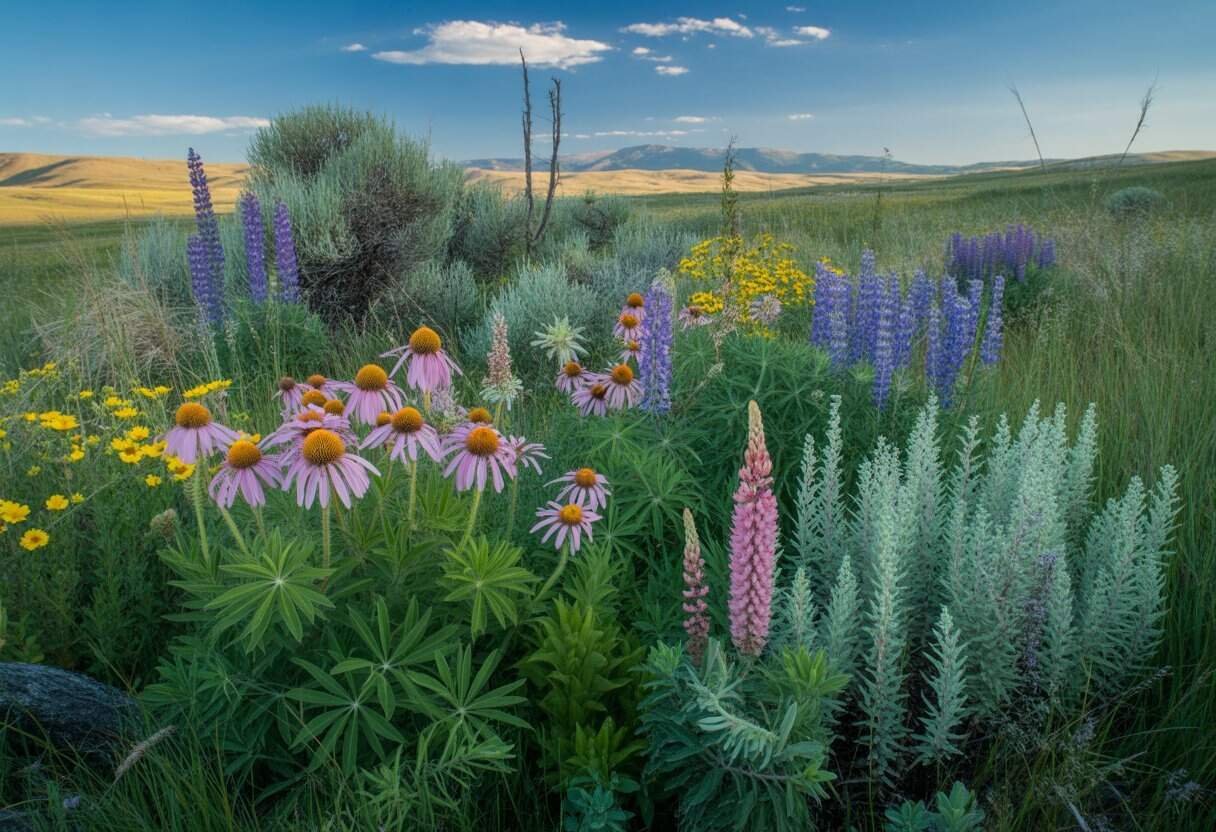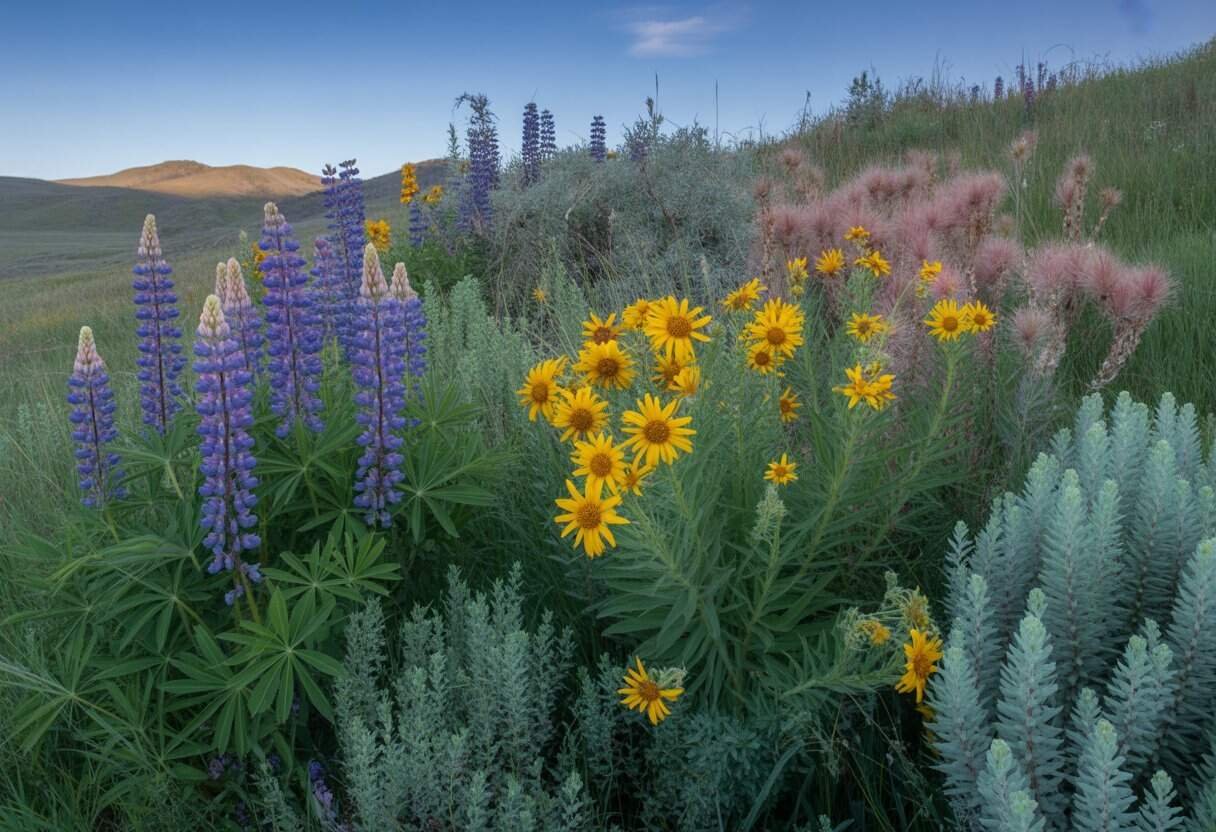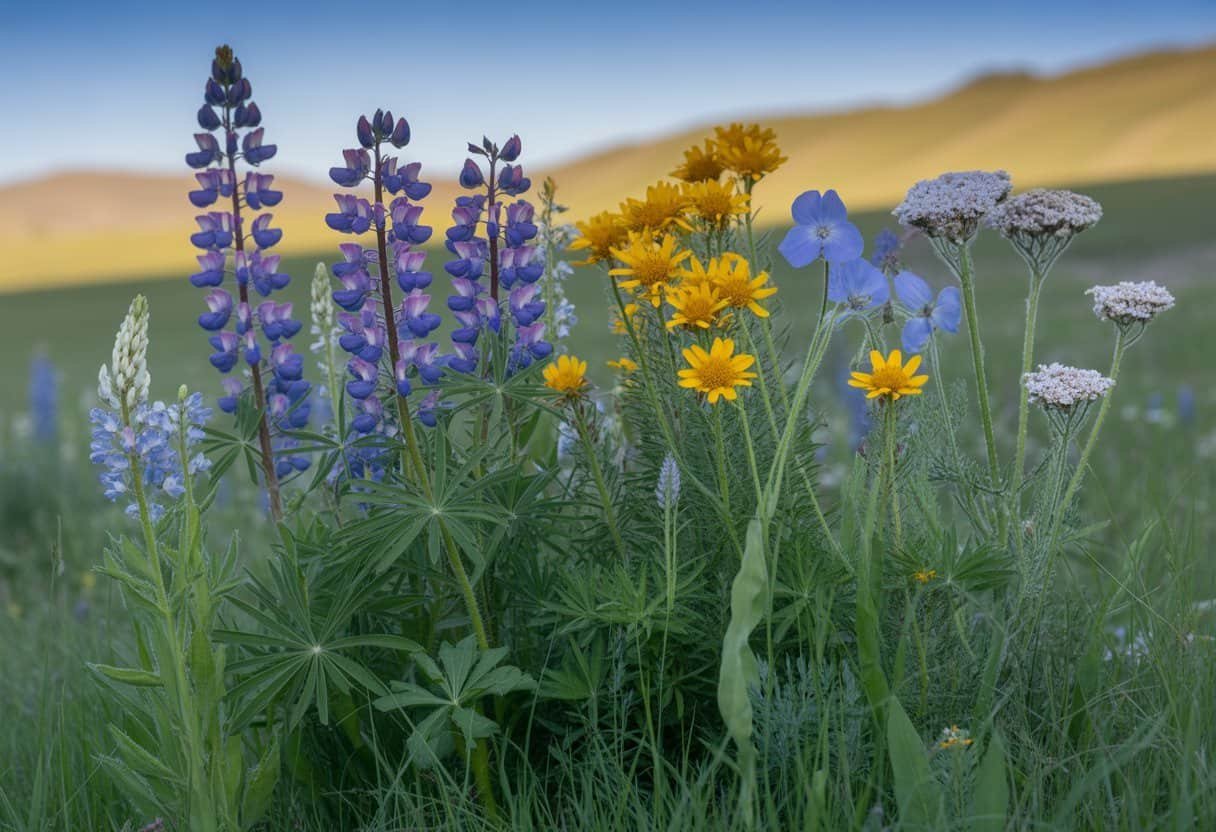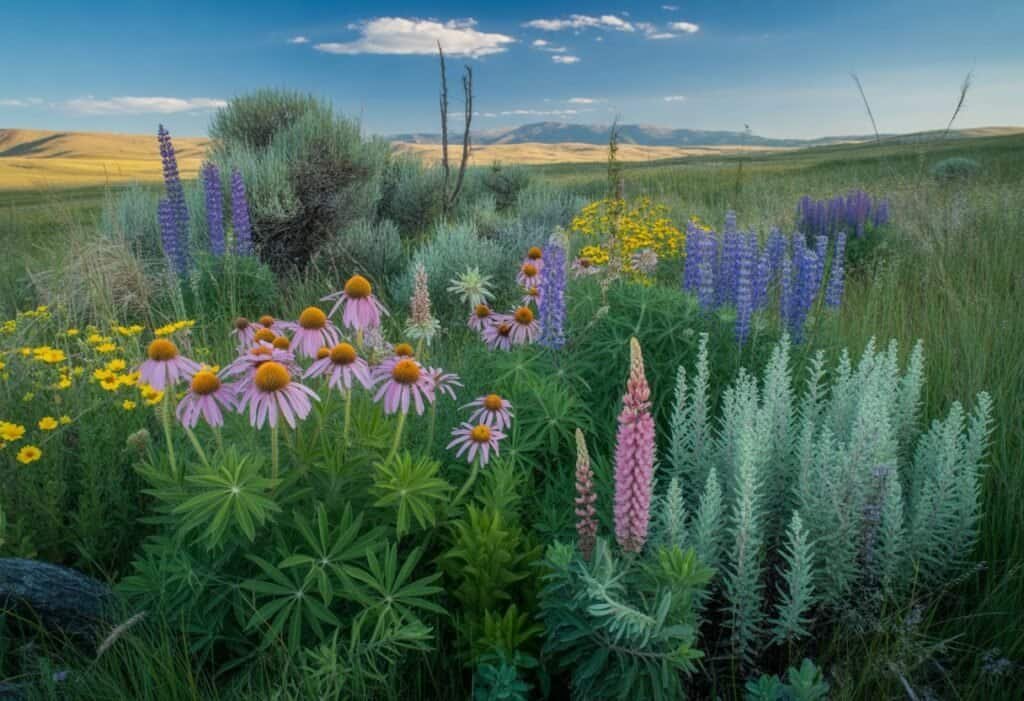Montana’s native plants have adapted to our state’s diverse landscapes over thousands of years. From the towering ponderosa pines of our forests to the delicate bitterroot flowers of our rocky hillsides, these plants tell the story of Montana’s natural heritage.
Native plants support local wildlife, conserve water, and create landscapes that truly belong in Montana’s unique environment.

These indigenous plants thrive without extra water or fertilizer once established. They make perfect choices for sustainable gardens.
Montana boasts over 1,500 native plant species across its varied ecosystems, from alpine meadows to prairie grasslands. Each plant plays a vital role in our state’s ecological balance.
Key Takeaways
- Montana native plants require less maintenance and water while providing essential habitat for local wildlife.
- Native plant species have adapted to Montana’s challenging climate and soil conditions over thousands of years.
- Using indigenous plants in gardens and landscapes helps preserve Montana’s natural heritage and ecological diversity.
Overview of Montana’s Native Plant Species
Montana’s landscape contains over 1,500 native plant species that thrive in the state’s diverse environments. These plants include prairie grasses, wildflowers, alpine species, and forest undergrowth.
Each species has adapted to Montana’s unique growing conditions. They flourish in habitats ranging from dry prairies to moist mountain meadows.
What Defines a Native Plant?
Native plants are species that evolved naturally in a region without human introduction. In Montana, these plants developed over thousands of years, adapting to the state’s specific soil conditions, precipitation patterns, and temperature extremes.
Montana’s native plants typically grow within USDA hardiness zones 3 to 6, depending on elevation and location. Many can survive winter temperatures dropping to -40°F in northern and mountainous regions.
Unlike introduced species, natives have developed complex relationships with local wildlife, microorganisms, and soil. They require less maintenance, fertilizer, and water once established.
Diversity and Adaptations in Montana
Montana’s varied landscape creates distinct plant communities across the state. Prairie regions feature drought-resistant species like blue grama grass, prairie coneflower, and echinacea.
In mountainous areas, plants like beargrass, glacier lily, and western red cedar have adapted to higher elevations and shorter growing seasons. These species also tolerate heavier snowfall.
Riparian areas host moisture-loving species such as cottonwoods, willows, and red osier dogwood. These plants often have specialized root systems for accessing water and stabilizing stream banks.
Many Montana natives show remarkable adaptations:
- Waxy leaf coatings that reduce water loss
- Hairy stems and leaves that insulate against extreme temperatures
- Drought-dormancy during dry periods
- Fire-resistant bark or rapid regeneration after wildfires
Significance of Native Plants in Local Ecosystems
Native plants form the foundation of Montana’s ecosystems and provide critical food and habitat for wildlife. Bitterroot, serviceberry, and chokecherry produce berries that feed bears, birds, and smaller mammals throughout summer and fall.
These plants support specialized pollinators including native bees, butterflies, and moths. The beautiful Lewis’s flax attracts specific bee species that have co-evolved with it.
Native grasses and wildflowers contribute to soil health by preventing erosion with their extensive root systems. This is especially important in Montana’s mountainous regions and along waterways.
Maintaining populations of native plants helps preserve the state’s biodiversity. This becomes increasingly important as climate change, development, and invasive species threaten native plant communities.
Iconic Montana Native Plants

Montana’s landscape is home to many distinctive native plants. These species have adapted to the state’s varied climate and terrain.
They play important roles in local ecosystems and connect deeply to Montana’s cultural heritage.
Bitterroot (Lewisia rediviva)
The Bitterroot is Montana’s state flower, named for its bitter-tasting roots. This low-growing plant produces stunning pink to white blossoms that appear in late spring.
Lewisia rediviva survives in rocky, harsh environments across Montana. Native Americans, especially the Salish and Kootenai tribes, harvested the roots as food.
The plant’s scientific name honors Meriwether Lewis of the Lewis and Clark expedition. Today, the Bitterroot Valley and Bitterroot Mountains bear its name.
The Bitterroot blooms from May to June with flowers that close at night and reopen in sunlight. Its fleshy taproot can survive for years in a dormant state during drought.
Ponderosa Pine (Pinus ponderosa)
The Ponderosa Pine stands as Montana’s most common native pine tree. These giants can grow over 100 feet tall and live for centuries.
Ponderosa Pines are easily identified by their puzzle-piece bark pattern, long needles grouped in bundles of three, and the vanilla or butterscotch scent in the bark crevices.
These trees provide crucial habitat for wildlife, including nesting sites for birds and shelter for mammals. Their seeds feed many forest creatures from squirrels to bears.
Ponderosas thrive in Montana’s drier forests and are fire-adapted with thick, insulating bark. After wildfires, they often dominate recovering forest areas.
Native Americans used parts of the tree for medicine, building materials, and food.
Big Sagebrush and Other Shrubs
Big Sagebrush dominates Montana’s eastern plains and creates the characteristic scent of the West. This silver-gray shrub grows 3-12 feet tall and serves as a cornerstone species in Montana’s shrubland ecosystems.
Wildlife relies heavily on sagebrush. The Greater Sage-Grouse depends on it for food and cover, while pronghorn, mule deer, and elk browse its leaves, especially in winter.
Other important native shrubs include:
- Antelope Bitterbrush
- Snowberry
- Chokecherry
- Silver Buffaloberry
These shrubs provide critical food and shelter for wildlife while stabilizing soil in harsh conditions. Many have traditional medicinal uses, with Native American tribes harvesting their berries, leaves, and bark.
Serviceberry and Saskatoon Berry
Serviceberry (Amelanchier alnifolia), also called Saskatoon berry, grows throughout Montana as a multi-stemmed shrub reaching 3-15 feet tall. It produces showy white flowers in spring before most trees leaf out.
The sweet purple berries ripen in mid-summer and were a staple food for Native American tribes. People still gather these nutritious berries for jams, pies, and eating fresh.
Serviceberry shrubs provide food for birds, bears, and small mammals. They offer nesting habitat for songbirds and browse for deer and moose.
The wood is exceptionally hard and was used for tools and arrow shafts. During fall, serviceberry leaves turn vibrant orange and red, adding color to Montana’s autumn landscapes.
Native Wildflowers of Montana

Montana’s landscape blooms with diverse native wildflowers from spring through fall. These hardy plants have adapted to the state’s varied climates and provide essential habitat for local wildlife.
Blanketflower and Aster
Blanketflower (Gaillardia aristata) stands out in Montana’s prairies with its bright red and yellow daisy-like blooms. This drought-tolerant perennial flowers from June through September and grows 1-2 feet tall.
Blanketflower attracts many pollinators, especially bees and butterflies. Its colorful appearance resembles a Native American blanket.
Several aster species thrive in Montana, including the showy aster (Eurybia conspicua) and the smooth blue aster (Symphyotrichum laeve). These late-blooming flowers provide crucial nectar for pollinators in late summer and fall.
Asters typically display purple to blue ray flowers with yellow centers. They adapt well to various Montana habitats, from dry grasslands to moist meadows.
Yarrow and Pearly Everlasting
Achillea millefolium, or yarrow, grows abundantly throughout Montana. This plant features flat-topped clusters of tiny white flowers and delicate, feathery foliage.
Native Americans used yarrow for medicinal purposes, treating wounds and illnesses. Today, yarrow remains valued for its drought tolerance and ability to attract beneficial insects.
Pearly Everlasting (Anaphalis margaritacea) has papery white flowers that seem to last forever. This perennial thrives in dry, open areas across Montana.
The plant’s silvery-white flower clusters bloom from July through September. Pearly Everlasting serves as a host plant for the American Lady butterfly, whose caterpillars feed on its leaves.
Prairie Smoke Geum and Harebells
Prairie Smoke (Geum triflorum) captivates with its unique appearance. In spring, nodding pink-red flowers emerge, followed by feathery, smoke-like seed heads.
This native perennial grows 6-18 inches tall and prefers well-drained soils. Indigenous peoples used Prairie Smoke roots for medicinal teas.
Growing conditions for Prairie Smoke:
- Soil: Well-drained, dry to medium moisture
- Light: Full sun to part shade
- Height: 6-18 inches
Harebells (Campanula rotundifolia) display delicate blue bell-shaped flowers on thin stems. These wildflowers bloom from June through September in Montana’s mountains and foothills.
Despite their fragile appearance, Harebells tolerate harsh conditions and even grow in rocky crevices. They provide nectar for hummingbirds and pollinating insects.
Rocky Mountain Iris and Lewis Flax
Iris missouriensis, the Rocky Mountain Iris, creates stunning purple-blue displays in moist Montana meadows. This early-blooming native emerges in May and June and grows 1-2 feet tall.
The Rocky Mountain Iris features the classic iris form with three upright petals and three drooping sepals. These moisture-loving plants often indicate areas with seasonal water.
Lewis Flax (Linum lewisii) produces delicate blue flowers that last just one day, with new blooms opening daily throughout summer. Explorer Meriwether Lewis gave this native its name.
Lewis Flax grows 1-2 feet tall with slender stems and narrow leaves. Native peoples used the strong stem fibers for making cordage and fishing nets.
Both these wildflowers attract many pollinators and add beautiful blue hues to Montana’s landscape.
Shrubs, Trees, and Woody Species
Montana’s landscape is enriched by diverse woody plants that have adapted to the state’s varied climate and terrain. These native species provide wildlife habitat, prevent erosion, and add beauty to Montana’s natural spaces.
Beargrass and Juniper Species
Beargrass (Xerophyllum tenax) isn’t a true grass but belongs to the lily family. This distinctive plant features long, grass-like leaves and tall flowering stalks topped with dense white flower clusters that can reach 5 feet in height.
Beargrass thrives in subalpine meadows and forests throughout western Montana. Indigenous peoples used its tough leaves for basket weaving and its roots for medicine.
Rocky Mountain Juniper (Juniperus scopulorum) is an evergreen that can live for centuries. These drought-resistant trees grow 20-30 feet tall with blue-gray berries and scale-like foliage.
Junipers provide shelter for birds and small mammals. Their berries feed wildlife in winter and have been used by Native Americans for food, medicine, and ceremonies.
Chokecherry, Buffaloberry, and Snowberry
Chokecherry shrubs produce clusters of small white flowers that develop into dark purple fruits. Native Americans traditionally processed these astringent berries into jellies and pemmican.
Buffaloberry shrubs have silvery leaves and bright red berries rich in vitamins. These nitrogen-fixing plants grow in poor soils and help restore land.
Snowberry gets its name from its distinctive white berries that persist through winter. These rounded shrubs grow 2-5 feet tall and thrive in habitats ranging from dry slopes to moist woodlands.
All three shrubs provide food and shelter for birds and wildlife. Their rhizomes help stabilize slopes and prevent soil erosion.
Rocky Mountain Maple and Redosier Dogwood
Rocky Mountain Maple (Acer glabrum) is a small deciduous tree or large shrub that reaches 20-30 feet tall. Its lobed leaves turn bright yellow and red in autumn, adding color to Montana’s landscapes.
This maple grows along streambanks and in moist mountain forests. Its winged seeds spin as they fall, helping them spread.
Redosier Dogwood stands out with bright red stems that add winter interest. In summer, it displays flat clusters of white flowers followed by white berries.
This dogwood prefers wet areas and is often used in riparian restoration. Its dense roots stabilize streambanks, and its berries feed over 90 species of birds and mammals.
Woods’ Rose and Mountainspray Clematis
Woods’ Rose produces fragrant pink flowers in early summer, followed by bright red rose hips rich in vitamin C. This thorny shrub grows 3-6 feet tall and forms thickets that offer wildlife cover.
Native bees and butterflies visit the flowers, while birds and small mammals eat the rose hips. Indigenous peoples used the hips for food and medicine.
Mountainspray Clematis climbs over rocks and other plants with twining stems. It produces clusters of white flowers followed by feathery seed heads that look like sprays of mist.
This vine adds vertical interest to Montana gardens and natural areas. Once established, it tolerates drought and provides nectar for pollinators. The seed heads offer winter interest and nesting material for birds.
Grassland and Prairie Native Plants
Montana’s grasslands and prairies host diverse native plants adapted to the open plains and changing weather. These plants support local wildlife and help maintain healthy soil across the state’s wide-open spaces.
Silky Lupine and Sundancer Daisy
Silky Lupine (Lupinus sericeus) thrives in Montana’s grasslands with blue-purple flower spikes that bloom from May to July. This perennial grows 1-2 feet tall and has silvery-green leaves covered in fine hairs.
Lupines fix nitrogen in the soil, improving conditions for other plants. However, they contain alkaloids that can be toxic to livestock, especially sheep.
Sundancer Daisy (Hymenoxys acaulis) brightens prairies with yellow blooms. This low-growing perennial, 4-8 inches tall, flowers from April through June and tolerates harsh conditions.
Its deep taproot helps it survive drought, making it ideal for Montana’s dry prairie regions. Bees and butterflies rely on these daisies for nectar during early summer.
Bluebunch Wheatgrass and Nodding Onion
Bluebunch Wheatgrass (Pseudoroegneria spicata) is Montana’s state grass and forms the backbone of many prairie ecosystems. This bunch grass grows 1-3 feet tall with bluish-green leaves.
Its deep roots reach up to 5 feet underground, making it very drought-resistant. Bison and other grazers fed on this grass, which provides winter forage even when dormant.
Nodding Onion (Allium cernuum) adds color to grasslands with pink to lavender flower clusters that droop on slender stems. This perennial grows 8-18 inches tall.
Despite its delicate look, Nodding Onion tolerates harsh prairie conditions. Native Americans used the bulbs for food and medicine, including treating colds and coughs.
Purple Prairie Clover and Littleflower Penstemon
Purple Prairie Clover (Dalea purpurea) displays purple-pink cylindrical flower heads on stems 1-3 feet tall. This nitrogen-fixing perennial improves soil quality.
Bees and butterflies visit the flowers from June through August. The plant’s deep taproot makes it drought-resistant and helps prevent soil erosion.
Littleflower Penstemon (Penstemon procerus) creates purple-blue patches in grasslands. This compact perennial grows 4-12 inches tall and produces many small, tubular flowers.
It blooms in early summer and adapts to various soil conditions. Hummingbirds and bees rely on this penstemon for nectar. It thrives in poor soils and helps restore disturbed prairie areas.
Ecological Value and Wildlife Benefits
Montana native plants support local ecosystems by providing resources for many species and maintaining ecological balance. These plants evolved alongside local wildlife, creating relationships that support biodiversity.
Attracting and Sustaining Pollinators
Native plants are crucial for Montana’s pollinators. Bees, butterflies, moths, and hummingbirds depend on these plants for nectar and pollen. Blue flax, blanketflower, and wild bergamot produce abundant nectar.
Montana native plants bloom at different times, providing a steady food supply for pollinators from spring through fall.
Planting a pollinator garden with native species helps counteract habitat loss. Even small gardens can support pollinators moving through fragmented landscapes.
Most native plants tolerate drought, so they continue to support pollinators during dry periods. Their deep roots access subsurface moisture, allowing them to produce nectar when non-native plants may not.
Supporting Montana’s Animals and Birds
Native plants provide food, shelter, and nesting materials for wildlife. Serviceberry and chokecherry produce berries that feed many birds and mammals. Grasses like blue grama and Idaho fescue offer cover for small animals.
Many animals rely on native plants for survival. Deer and elk browse on native shrubs during winter when other food is scarce. Ground-nesting birds use native grasses for cover.
Native plant seeds feed animals through Montana’s harsh winters. Sunflower, coneflower, and aster produce seeds that remain available even under snow.
The drought tolerance of native plants helps wildlife habitats stay stable during dry years.
Using Native Plants in Landscaping and Gardening
Montana’s native plants offer practical benefits for gardens and landscapes. They need less water, maintenance, and fertilizer while providing habitat for wildlife and preserving Montana’s natural beauty.
Xeriscaping and Drought-Resistant Design
Xeriscaping uses Montana native plants to create beautiful landscapes that need little water. This approach works well in the state’s drier regions where water conservation is important.
Native grasses like Blue Grama and Idaho Fescue make excellent drought-resistant ground covers. These grasses develop deep roots that access groundwater without frequent irrigation.
Shrubs such as Big Sagebrush and Rabbitbrush thrive in xeriscapes. They add structure and visual interest and need almost no supplemental water once established.
Design principles for xeriscaping include:
- Grouping plants with similar water needs
- Using mulch to reduce evaporation
- Minimizing lawn areas
- Installing efficient irrigation systems
Plant Selection for Specific Climates
Montana’s varied climate zones require careful plant selection. The eastern plains have hotter summers and colder winters than the western mountains.
Mountain Regions: Plants like Beargrass, Columbine, and Mountain Lupine thrive at higher elevations. They handle shorter growing seasons and more snow.
Eastern Plains: Prairie Smoke, Purple Coneflower, and Little Bluestem tolerate the temperature extremes and drier conditions found in eastern Montana.
Soil type also matters. Clay soils work well with Penstemon and Yarrow, which tolerate poor drainage. Sandy soils suit deep-rooted natives like Blanketflower.
Low-Maintenance Native Perennials
Native perennials save time and resources in Montana gardens. Once established, they need little attention beyond occasional pruning.
Top Low-Maintenance Choices:
- Blanketflower: Bright flowers from June through September
- Beebalm: Attracts pollinators with vibrant blooms
- Rocky Mountain Penstemon: Drought-tolerant with blue-purple flowers
- Lewis Flax: Delicate blue flowers on wiry stems
These plants return year after year without replanting. Their natural resilience helps them resist pests and diseases without chemicals.
Most native perennials need division only every 3-5 years. This simple task keeps plants healthy and provides new starts for expanding gardens or sharing with neighbors.
Community Resources and Conservation
Montanans work to protect their native plant heritage through organizations and restoration projects. These efforts preserve the state’s unique botanical diversity for future generations.
Montana Native Plant Society and Organizations
The Montana Native Plant Society (MNPS) is the state’s main resource for native plant information and advocacy. Founded in 1987, MNPS has seven chapters across Montana, offering field trips, workshops, and educational programs. Members receive the “Kelseya” newsletter with updates on native plant issues and events.
Several botanical gardens in Montana showcase native plants. The Montana Arboretum and Gardens in Missoula and the Lewis and Clark Native Plant Garden in Great Falls display indigenous species in educational settings. Visitors can observe native plants in curated environments.
University extension offices provide valuable resources. Montana State University’s Extension Service offers publications, identification guides, and expert advice on native plant cultivation and conservation.
Conservation Efforts and Native Plant Restoration
Montana’s conservation initiatives focus on preserving native plant habitats threatened by development, climate change, and invasive species. The Montana Natural Heritage Program monitors rare plant populations and tracks their conservation status.
Several restoration projects are rebuilding native ecosystems:
- The Crown of the Continent project restores alpine plant communities
- Prairie restoration in eastern Montana reestablishes native grasses
- Riparian recovery along the Yellowstone and Missouri rivers
Public land agencies like the Bureau of Land Management and U.S. Forest Service maintain seed banks of native Montana plants. These collections preserve genetic diversity and provide materials for restoration.
Private landowners can help through conservation easements that protect native plant habitats. The Montana Land Reliance has secured over 1 million acres through these agreements, safeguarding native plant communities on private land.
Frequently Asked Questions
Montana’s native plants have adapted to the region’s climate and soils over thousands of years. These species support local wildlife and create landscapes that thrive with minimal care.
Which plants are indigenous to Montana’s landscapes and ecosystems?
Montana has over 1,500 native plant species across diverse landscapes. Common trees include Ponderosa Pine, Douglas Fir, and Quaking Aspen, which dominate forests.
Prairie ecosystems feature grasses like Bluebunch Wheatgrass, Idaho Fescue, and Rough Fescue. These grasses once covered millions of acres before agriculture.
Wildflowers such as Bitterroot (the state flower), Blanketflower, and Prairie Coneflower add color to Montana’s meadows and mountains.
How can one identify Montana’s native flora?
Field guides specific to Montana or the Northern Rockies provide descriptions and images for plant identification. These guides often organize plants by flower color, leaf shape, or habitat.
Plant identification apps like iNaturalist and PlantNet let users photograph specimens and get possible matches. These tools have become accurate and helpful for beginners.
Local nurseries specializing in native plants offer expertise and examples. Many have display gardens with labeled native species.
What are the best native plants in Montana to attract and support local pollinators?
Blanketflower (Gaillardia aristata) attracts many bee species and butterflies with a long blooming period. Its drought tolerance suits Montana gardens.
Bee Balm (Monarda fistulosa) draws hummingbirds, butterflies, and native bees. This perennial produces lavender flowers from June through August.
Milkweed species (Asclepias) serve as host plants for Monarch butterflies. Showy Milkweed and Swamp Milkweed both thrive in Montana habitats.
What are the top native flowering plants to incorporate into a Montana garden?
Lewis’s Blue Flax offers delicate blue flowers that bloom all summer. This drought-resistant plant reseeds easily and needs little care.
Rocky Mountain Penstemon produces purple-blue tubular flowers that attract hummingbirds. Its compact growth fits well in borders or rock gardens.
Yarrow displays clusters of white or yellow flowers above ferny foliage. This plant tolerates poor soil and dry conditions.
Which native Montana plants are recommended for drought-resistant landscaping?
Rabbitbrush thrives in harsh conditions with minimal water once established. Its silver-green foliage provides year-round interest and features yellow flowers in late summer.
Pasqueflower survives Montana’s challenging climate with deep taproots. Its early spring purple blooms and feathery seed heads add visual interest.
Prairie Smoke creates a striking display with its nodding pink flowers. Its distinctive feathery seed heads stand out, and this ground cover spreads slowly in well-drained soils.
What are the native herbs that can be found in the wilds of Montana?
Wild Bergamot (Monarda fistulosa) produces aromatic leaves used for tea. Native Americans used this mint family member for cooking and medicine.
Yarrow leaves and flowers have traditional medicinal uses. Many Montanans use this herb for teas and poultices.
Wild Mint grows in moist areas throughout Montana. Its distinctive fragrance makes it easy to identify, and people use its leaves to flavor teas and dishes.


